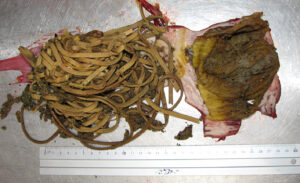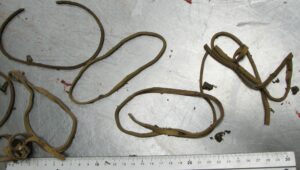Stomach of dead white stork full of rubber bands
The DWHC received a dead white stork (Ciconia ciconia) on June 18th 2019 to investigate the cause of death. The animal was collected from the municipality of Hilvarenbeek, province of Noord-Brabant.
Glandular stomach full of rubber bands
 The white stork was an adult female in a poor nutritional state. At dissection her glandular stomach turned out to be extremely expanded by a large ball of rubber bands (see top photo). The rubber bands were of a type such as those used for bundling letters (see bottom photo). There was almost no normal food left in the stomach. There were a few small pieces of rubber band in the gizzard. The intestines were almost empty, containing no rubber and as good as no food parts. Possibly, this white stork has mistaken the rubber bands for (earth)worms.
The white stork was an adult female in a poor nutritional state. At dissection her glandular stomach turned out to be extremely expanded by a large ball of rubber bands (see top photo). The rubber bands were of a type such as those used for bundling letters (see bottom photo). There was almost no normal food left in the stomach. There were a few small pieces of rubber band in the gizzard. The intestines were almost empty, containing no rubber and as good as no food parts. Possibly, this white stork has mistaken the rubber bands for (earth)worms.
A common problem
 There are more reports of white storks with problems due to eating rubber bands. Last Monday, June 17th, for example, it was stated on the website of RTV Utrecht that a young white stork died after eating rubber bands. The website of the Storks Research & Know-how Foundation (STORK) also posted a message in September 2016 about a white stork that had a twisted neck. This animal turned out to have a large amount of rubber bands in the oesophagus (gullet) that had to be removed by a veterinarian so the stork could be saved.
There are more reports of white storks with problems due to eating rubber bands. Last Monday, June 17th, for example, it was stated on the website of RTV Utrecht that a young white stork died after eating rubber bands. The website of the Storks Research & Know-how Foundation (STORK) also posted a message in September 2016 about a white stork that had a twisted neck. This animal turned out to have a large amount of rubber bands in the oesophagus (gullet) that had to be removed by a veterinarian so the stork could be saved.
References (Dutch):
RTV Utrecht Jonge ooievaar legt het loodje na eten elastiekjes: (https://www.rtvutrecht.nl/nieuws/1935903/jonge-ooievaar-legt-het-loodje-na-eten-elastiekjes.html)
STORK: Elastiek of regenworm? (http://www.ooievaars.eu/0390ooievaars_indeproblemen/default.html#elastiek)



